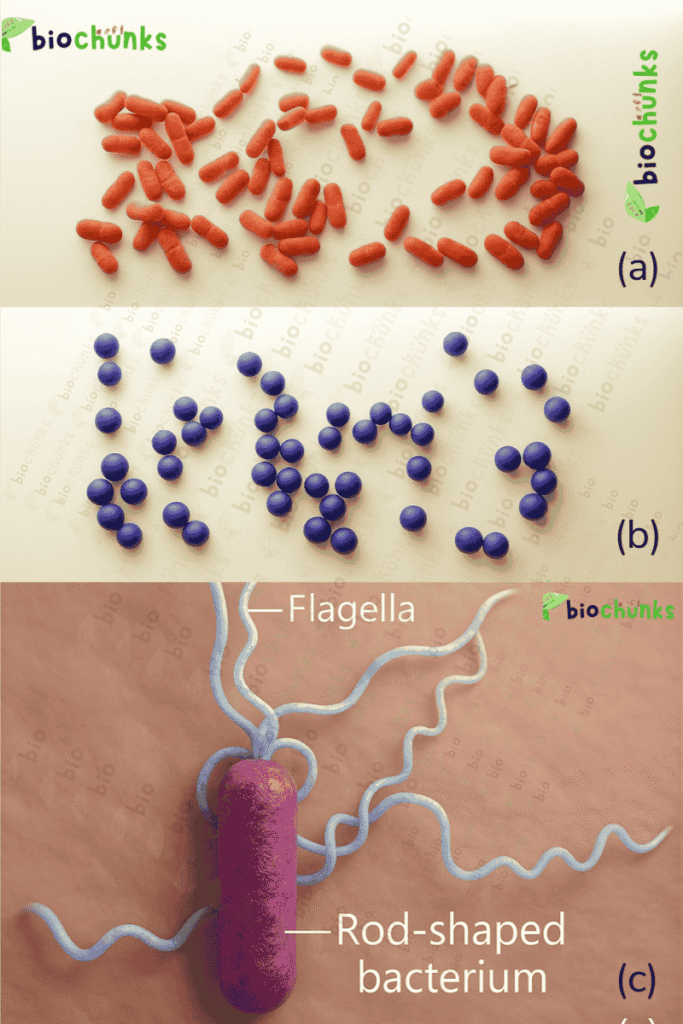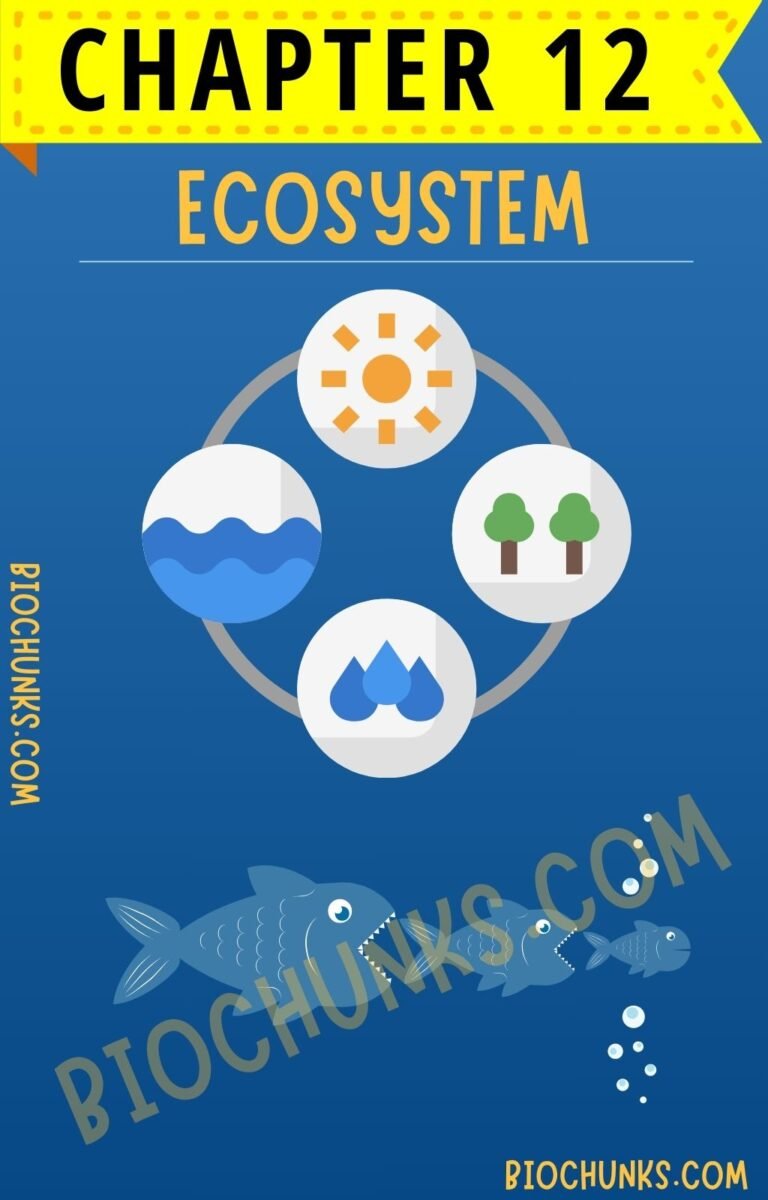Table of Contents (tap to open/close)
Microbes: A Vital Part of Life
This chapter Microbes in Human Welfare, focuses on the diverse roles of microbes in various fields, including household products, industrial applications, sewage treatment, biogas production, biocontrol, and biofertilizers.



Where are Microbes Found?
- Microbes are everywhere: soil, water, air, inside our bodies, in animals, and plants.
- They thrive even in extreme conditions: deep in hot geysers, soil, snow, and acidic environments.
Types of Microbes
- Diverse forms: protozoa, bacteria, fungi, viruses, viroids, and prions.
- Can form visible colonies on nutritive media (e.g., bacteria, fungi).
Importance of Microbes
- Not all microbes are harmful; many are beneficial.
- They play a crucial role in various processes and products we use daily.
Microbes in Household Products
Making Curd
- Microbes involved: Lactobacillus and lactic acid bacteria (LAB).
- Process: LAB grow in milk, produce acids, coagulate, and partially digest milk proteins.
- Benefit: Increases nutritional quality by adding vitamin B12.
- Role in stomach: LAB help check disease-causing microbes.
Fermenting Dough
- Foods: Dosa and idli.
- Process: Bacteria ferment dough, producing CO2, making it puffed-up.
- Bread: Fermented using baker’s yeast (Saccharomyces cerevisiae).
Traditional Drinks and Foods
- Toddy: Made by fermenting sap from palm tree in southern India..
- Other fermented foods: Fish, soyabean, bamboo shoots.
Cheese Production
- Swiss cheese: Large holes due to CO2 production by Propionibacterium sharmanii (a bacterium).
- Roquefort cheese: Ripened by specific fungi (Penicillium roqueforti), giving it a unique flavor.
Microbes in Industrial Products

Fermented Beverages
- Microbes used: Yeasts, especially Saccharomyces cerevisiae (brewer’s yeast).
- Products: Wine, beer, whisky, brandy, rum.
- Process: Yeast ferments malted cereals and fruit juices to produce ethanol.
- Types of alcoholic drinks:
- Without distillation: Wine, beer.
- With distillation: Whisky, brandy, rum, gin, arrack.

Antibiotics
- Definition: Chemical substances produced by microbes that kill or inhibit other microbes.
- Significance: Major discovery of the 20th century, vital for human health.
- First antibiotic: Penicillin.
- Discovery: Alexander Fleming noticed mould (Penicillium notatum) that inhibited Staphylococci bacteria. He extracted penicillin from it & named antibiotics after the mould Penicillium notatum.
- Development: Full potential realized by Ernest Chain and Howard Florey.
- Use: Extensively used in World War II to treat soldiers.
- Recognition: Fleming, Chain, and Florey awarded Nobel Prize in 1945.
Impact of Antibiotics
- Improved treatment: Diseases like plague, whooping cough, diphtheria, and leprosy.
- Modern medicine: Essential for treating bacterial infections; world unimaginable without antibiotics.
Chemicals, Enzymes, and Other Bioactive Molecules
Microbes are used in industries to produce various chemicals, enzymes, and bioactive molecules. Here’s how:
Organic Acid Producers
- Citric Acid: Produced by Aspergillus niger (fungus).
- Acetic Acid: Produced by Acetobacter aceti (bacterium).
- Butyric Acid: Produced by Clostridium butylicum (bacterium).
- Lactic Acid: Produced by Lactobacillus (bacterium).
Alcohol Producers
- Ethanol: commercially Produced by yeast (Saccharomyces cerevisiae).
Enzyme Producers
- Lipases: Used in detergents to remove oily stains.
- Pectinases and Proteases: Used to clarify bottled fruit juices.
Medical Uses
- Streptokinase: Produced by Streptococcus, used as a ‘clot buster’ for heart attack patients.
- Cyclosporin A: Produced by Trichoderma polysporum (fungus), used as an immunosuppressive agent in organ transplants.
- Statins: Produced by Monascus purpureus (yeast), used to lower blood cholesterol by inhibiting cholesterol synthesis enzyme.
Microbes in Sewage Treatment
What is Sewage?
- Sewage: Wastewater from cities and towns, mostly containing human waste.
- Problem: Sewage has a lot of organic matter and harmful microbes and cannot be directly discharged into natural water bodies.
- Solution: Sewage is treated in Sewage Treatment Plants (STPs) before being released into rivers or streams.
Sewage Treatment Process
- Sewage is treated in Sewage Treatment Plants (STPs) to reduce its pollution levels.
- Sewage treatment is done in two main stages:
Primary Treatment
- Purpose: Physical removal of large and small particles from sewage.
- Steps:
- Filtration: Removes floating debris.
- Sedimentation: Removes grit (soil and small pebbles).
- Outcome:
- Primary Sludge: Solids that settle at the bottom.
- Effluent: Liquid (supernatant) that remains after sedimentation and later moves to secondary treatment process.
Secondary Treatment (Biological Treatment)

- Process:
- Aeration Tanks: Effluent is pumped into tanks where air is pumped in and it is agitated (mixed).
- Microbial Growth: Due to aeration, useful aerobic microbes vigorously grow and form flocs (bacterial and fungal masses) and consume organic matter.
- BOD Reduction: Microbes consume organic matter, reducing Biochemical Oxygen Demand (BOD) of the effluent. learn more about BOD below (slider)
- The effluent is then passed to a settling tank for further process.
- Outcome:
- Activated Sludge: Bacterial flocs are allowed to settle in settling tank, forming sludge.
- A small portion of the activated sludge is pumped back into the aeration tank to act as the inoculum.
- Anaerobic Sludge Digesters:
- Activated sludge goes to anaerobic digesters (large tanks).
- Anaerobic bacteria digest the sludge, producing biogas (methane, hydrogen sulfide, carbon dioxide).
- Effluent: Water with reduced BOD, released into rivers.
- Activated Sludge: Bacterial flocs are allowed to settle in settling tank, forming sludge.

Importance of Sewage Treatment
- Effluent Disposal: Treated effluent is released into natural water bodies.
- Microbial Role: Microbes play a crucial role in treating wastewater globally.
- Urbanization Challenge: Increasing urbanization leads to more sewage, but not enough STPs.
Government Initiatives
- Ganga and Yamuna Action Plans: Aim to build more sewage treatment plants (STPs) to reduce river pollution.
- Educational Visits: Visiting a sewage treatment plant can be educational.
Microbes have been used in sewage treatment for over a century, and no man-made technology has matched their efficiency.
Microbes in Production of Biogas
What is Biogas?
- Biogas: A mixture of gases (mainly methane) produced by microbes, used as fuel.
- Methanogens: Certain anaerobic bacteria, like Methanobacterium, produce methane, CO2, and H2 from cellulosic material.
Where Are Methanogens Found?
- Anaerobic Sludge: During sewage treatment.
- Rumen of Cattle: Part of the stomach where they help break down cellulose in cattle food.
- Cattle Dung (Gobar): Rich in methanogens, used to produce biogas.

How is Biogas Produced?
- Biogas Plant Structure:
- Concrete Tank: 10-15 feet deep, collects bio-wastes and dung slurry.
- Floating Cover: Placed over the slurry, rises as gas is produced due to microbial activity.
- Outlet Pipe: Supplies biogas to nearby houses.
- Spent Slurry Outlet: Spent slurry used as fertilizer.
- Process:
- Bio-wastes and dung slurry are fed into the tank.
- Microbial activity produces biogas.
- Floating cover rises, and gas is piped to homes.
Uses of Biogas
- Cooking and Lighting: Common uses in rural areas.
- Fertilizer: Spent slurry from the biogas plant used as manure/fertilizer.
Development of Biogas Technology in India
- Organizations Involved:
- Indian Agricultural Research Institute (IARI)
- Khadi and Village Industries Commission (KVIC)
Microbes as Biocontrol Agents
What is Biocontrol?
- Biocontrol: Using biological methods instead of chemicals to control plant diseases and pests.
- Problems with Chemicals: Insecticides and pesticides are toxic, harmful to humans and animals, kill both useful and harmful organisms, and pollute the environment.
Benefits of Biocontrol
- Natural Predation: Relies on natural predators rather than chemicals to control pests..
- Organic Farming: Promotes biodiversity and sustainability.
- Holistic Approach: Understanding interactions between organisms helps manage pests without eradicating them.
Examples of Biocontrol Agents
- Ladybirds (beetle) and Dragonflies: Control aphids and mosquitoes.
- Bacillus thuringiensis (Bt):
- Used to control butterfly caterpillars.
- Available as dried spores mixed with water and sprayed on plants (brassicas and fruit trees).
- Toxin released in caterpillar/larvae’s gut kills them.
- Bt-cotton: Genetically engineered to be pest-resistant.
- Trichoderma:
- Free-living fungi in root ecosystems.
- Effective against several plant pathogens.
- Baculoviruses:
- Pathogens for insects and arthropods.
- Genus Nucleopolyhedrovirus: Narrow spectrum insecticidal applications.
- No negative impact on plants, mammals, birds, fish, or non-target insects.
Importance of Biocontrol
- Reduces Chemical Use: Minimizes dependence on toxic chemicals.
- Environmentally Friendly: Safe for beneficial insects and ecologically sensitive areas.
- Integrated Pest Management (IPM): Combines biocontrol with other methods for effective pest management.
Using biocontrol agents helps maintain a healthy and balanced ecosystem, making it a sustainable method for managing pests and plant diseases.
Microbes as Biofertilisers
Environmental Concern:
- Chemical fertilizers are used a lot in farming.
- They cause environmental pollution.
- Biofertilisers are an eco-friendly alternative.
What are Biofertilisers?
- Organisms that enrich soil nutrients.
- Main sources/Example: bacteria, fungi, and cyanobacteria.
Bacteria as Biofertilisers:
- Rhizobium:
- Lives in root nodules of leguminous plants (symbiotic relationship).
- Fixes atmospheric nitrogen into organic forms.
- Free-living bacteria:
- Live in soil and fix nitrogen.
- Examples: Azospirillum, Azotobacter.
Fungi as Biofertilisers:
- Mycorrhiza: Symbiotic association between fungi (like Glomus) and plant roots.
- Fungi absorb phosphorus from soil and passes it to plants.
- Benefits to plants: resistance to other pathogens, tolerance to salinity and drought, increased growth.
Cyanobacteria as Biofertilisers:
- Autotrophic microbes found in water and soil, can fix atmospheric nitrogen.
- Examples: Anabaena, Nostoc, Oscillatoria.
- Important biofertilisers in paddy fields.
- Also add organic matter to the soil, increasing fertility.
Current Use:
- Biofertilisers are commercially available in India.
- Farmers use them to replenish soil nutrients and reduce chemical fertilizer dependence.
Chapter Summary:
- Microbes are very important for life on earth.
- Not all microbes cause diseases; many are useful.
- We use microbes and their products daily.
- Lactic acid bacteria (LAB) grow in milk to make curd.
- Yeast called Saccharomyces cerevisiae ferments dough to make bread.
- Microbes ferment dough for dishes like idli and dosa.
- Bacteria and fungi give cheese its texture, taste, and flavor.
- Microbes produce industrial products like lactic acid, acetic acid, and alcohol.
- Antibiotics like penicillin from microbes kill harmful disease-causing microbes.
- Antibiotics control diseases like diphtheria, whooping cough, and pneumonia.
- For over 100 years, microbes treat sewage (waste water) by activated sludge formation.
- Methanogens produce methane (biogas) from plant waste.
- Biogas from microbes is used as energy in rural areas.
- Microbes can kill harmful pests, a process called biocontrol.
- Biocontrol helps avoid using toxic pesticides.
- There is a need to use biofertilizers instead of chemical fertilizers.
- Microbes play an important role in human society’s welfare.




